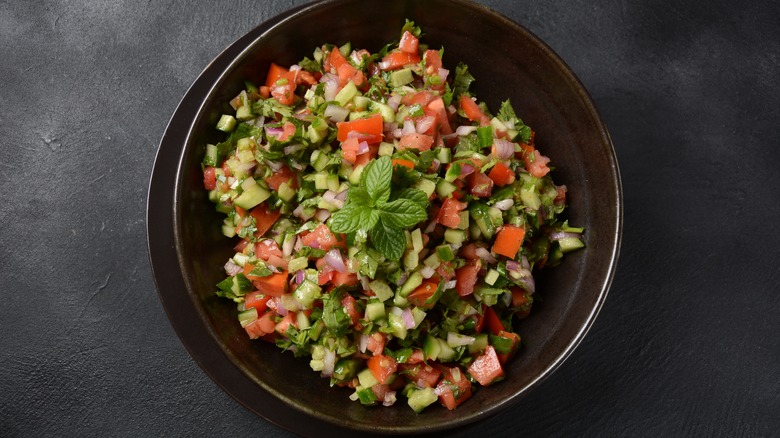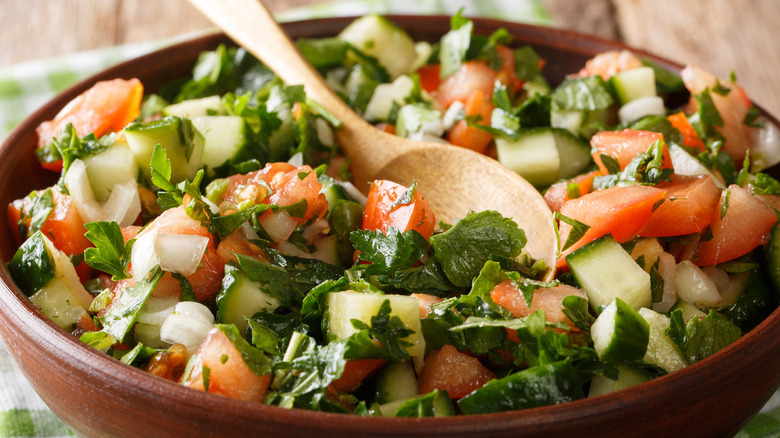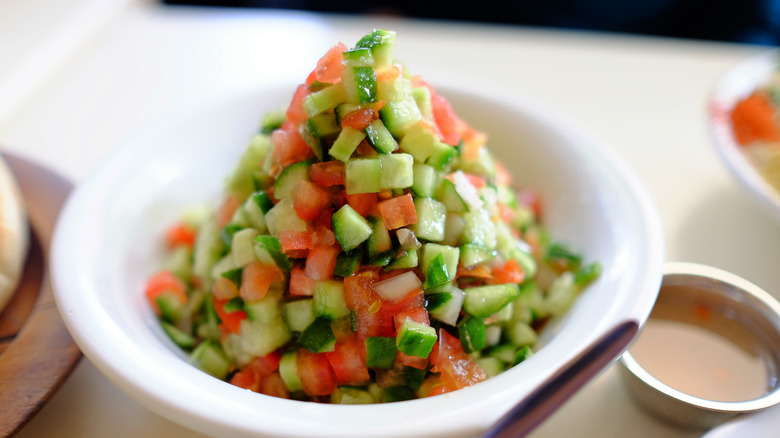The Small Difference That Sets Shirazi Salad Apart From Israeli Salad
If you think salad is defined by lettuce and may be a touch mundane because of it, you need only to look to salads from around the world to break that mindset. While salad has come to mean greens and other vegetables topped with dressing in the U.S., elsewhere the definition is looser, encompassing any number of vegetables, cheeses, proteins, starches or grains, and dressings. Perhaps one of the boldest and most refreshing is Israeli salad with chunks of cucumber, tomato, and onions in a vibrant dressing. Another similar salad, Shirazi salad, can lead to some confusion. Both are tasty eats that pack in fiber and nutrients, but a subtle difference sets them apart.
Israeli salad hails, as you would surmise, from Israel and is beloved as an icon of the nation's gastronomy. That gastronomy, as with many other cultural elements, has a considerable amount of overlap with that of its neighbors. So, it should be of little surprise that there are such exceedingly similar salads eaten in the region. Shirazi salad is an Iranian dish, though. Like its Israeli counterpart, cucumbers, tomatoes, onions, peppers, and olive oil are the central components. The difference boils down to herbs. Shirazi salad often has the refreshing bite of fresh chopped mint mingling with the ingredients, while Israeli salad has the more bracing bitterness of parsley. The former typically makes use of verjuice in its dressing while the latter opts for citrus.
An Iranian specialty
Shirazi salad, AKA salad-e Shirazi, is not a monolith and you can find plenty of variations of the recipe online, just as you might find Iranian chefs and cooks who add their own spin. The immutable ingredients of a Shirazi salad are the cucumber (always the smaller seedless Persian variety,) tomato, and red onion. The dressing is typically made from olive oil and verjuice, the acidic juice of unripe grapes. That said, lime is an occasional substitute for the verjuice — at times rendered as verjus or ab ghooreh in Iranian — and it isn't uncommon to find recipes that include lemon juice. Mint is also de rigueur in Shirazi salad, but it isn't always alone. Frequently mint will be paired with herbs like parsley, dill, or sumac, all of which add their unique layers to the salad.
With an abundance of textured, bright vegetables, it should surprise no one to learn that Shirazi salad is a summer dish. Making use of your garden's bounty, you can typically find the salad served with roasted meats and rice to offset the savory richness and satisfying starchiness of both.
Israel's national salad
Meaty and heavily-spiced, shawarma wrapped in pita or served as part of a combination plate can be a delicious undertaking, but an undertaking nonetheless. Thankfully, many Israeli-centered restaurants offering shawarma and other delicacies, like falafel, serve Israeli salad for that all-important balance. The cool crunch of the vegetables, the nip of the acidic dressing, and the punch of the herbs finds a welcome home upon the canvas of shaved meat and pita of a shawarma sandwich.
Again, cucumber, tomato, onions, and peppers are critical components, as is the generous dose of chopped parsley. Of course, some folks enjoy the freshness of mint, and as such it is not uncommon to see it included, further blurring the lines between the two salads. Minced garlic may also appear in Israeli salad, further deepening the spice. The dressing is almost always lemon juice and olive oil, with nary a hint of verjuice. This means, when compared to a verjuice-dressed Shirazi salad, Israeli salad will be slightly more fruit-forward.


